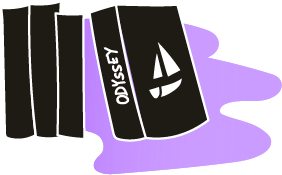Title of the resource
Title of the resource in english
Publisher
Éditions Nathan
Original language
Target and Age Group
9 - 12 years old
Link to resource
Author of the Entry:
Marta Pszczolińska, University of Warsaw, m.pszczolinska@al.uw.edu.pl
Peer-reviewer of the Entry:
Elżbieta Olechowska, University of Warsaw, elzbieta.olechowska@gmail.com
Second Peer-reviewer of the Entry:
Ayelet Peer, Bar- Ilan University, ayelet.peer@biu.ac.il
Thomas Bouhours
Thomas Bouhours - Holder of CAPES in classical languages, high school teacher, author or co-author of textbooks for Latin and French such as: Français 3e: Sujets & corrigés; Latin 3e: Programme 2012; Mon Brevet facile - Epreuve de Français 3éme; Dixit! Cahier de latin 4e; Dixit! 5e Cahier de latin; Ma 2de épreuve écrite Brevet Français/ Histoire-Géographie/ Enseignement moral et civique 3E (Mon brevet facile).
Arnaud Laimé
Arnaud Laimé - Lecturer at l'Université Paris 8 in Latin language and literature, literary historian. His research interests cover Graeco-Latin and French literature, reception of Antiquity and Renaissance, transfer of knowledge between France and Italy, integration of the Italian humanistic culture in Paris during the first French Renaissance, poetics of the interaction between Renaissance Latin and vernacular languages, works by Jacques Abeille.
source: univ-paris8.fr (accessed: February 09, 2020)
Claire Laimé-Couturier
Claire Laimé-Couturier - Head of Preparatory Literary Classes, Associate Professor of Classical Literature, author and director of Nathan collections
Camille Naulin
Camille Naulin - Associate Professor of Grammar, high school teacher, the co-author of Dixit 3e, Dixit 4e, Dixit 5e.
Contents & Purpose
Dixit! 5e (Cahier de latin. Langue et culture) is a French textbook for Latin language and culture with a special focus on the cultural aspect along with its European reception. The textbook is correlated with the curriculum of other school subjects; it also features a variety of activities available online or through the application Nathan live containing audiovisual resources, animated classes and interactive exercises.
The textbook is divided into 6 units: 1. Tous le chemins mènent à Rome [All roads lead to Rome], 2. L’origine de Rome [Origin of Rome], 3. Rome et ses voisins [Rome and its neighbours], 4. À la maison [At home], 5. Au fil de la vie [Throughout life], 6. Dieux et héros [Gods and heroes]. Every 2 chapters there is a four-page section entitled: Enquêtes mythologiques [Mythological Research], À la découverte du latin médiéval [Discovering Mediaeval Latin] and Belles et rebelles antiques [Ancient Beauties and Rebels]. Towards the end of the book one can find quizzes, grammatical tables of declension and conjugation, a glossary, an authors’ index, a two-page spread of ancient gods and a map of Italy.
Each unit begins with a two-page presentation of the topic, which includes photographs, illustrations and a Latin text alongside a French translation (or a partial translation, with an intention for it to be completed as an exercise). The next two pages provide a section entitled D’une langue à l’autre [From one language to another], which allows us to learn, memorize and broaden our Latin vocabulary in respect to other modern languages. The following two pages Étude de la langue [Language study] aim to present the grammatical topic of the lesson along with relevant exercises. Further, another two-page section is called an Atelier de traduction [Translatory workshop] focused on exercises intended to develop one’s translatory skills. Next, there are two pages dedicated to art and culture to enable the student to identify and analyse works of art and aspects of Latin civilization relevant to the programme. Each chapter ends with a Bilan [Review], which is a summary of what one has learned throughout the unit and can be used as a form of self-evaluation.
The student encounters ancient culture in all sections, not only those dedicated to culture or art; there are also many opportunities to familiarise oneself with the process of the constant presence of Antiquity in European civilisation of different eras.
Ancient mythology is featured in Dossier 1 and Chapter 6. The section presents genealogy of gods according to Apollodorus as well as metamorphoses of Daphne, Lycaon, Acteon and Arachne, illustrated with pieces of art. In chapter 6 the starting point is the plafond Concilio degli dei by Raphael (below) from loggia di Psiche (Roma, villa Farnesina), which presents the Greek Olympic gods. The authors introduce short sentences in Latin about each of the corresponding Roman gods, the symbol and identifying features. In the cultural spread the authors included a passage about Hercules in flames and the death of Deianira as a result of the centaur Nessus’ plot. In addition, the student is asked to identify ancient gods and their attributes on provided paintings from the Louvre Museum. These include: Neptune by Étienne Jeaurat, Diana the Huntress (Diane chasseresse, a portrayal of Diana de Poitiers) of the School of Fontainebleau and a fragment of Minerva with the Muses by Jacques Stella (all below). The last two pages of the book constitute a sort of spread of Roman gods with their respective Greek names and are illustrated with works of art and artefacts from various periods.
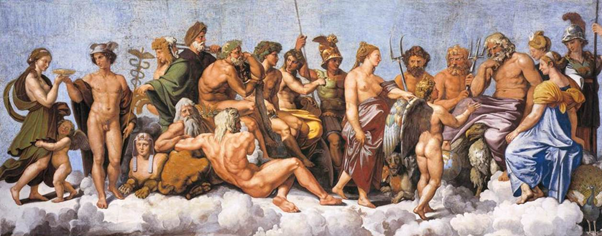
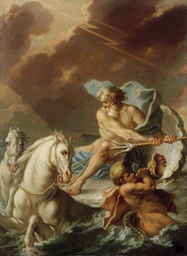
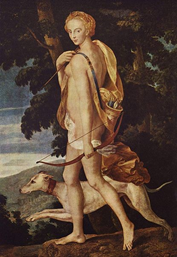
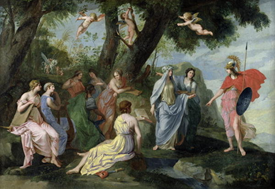
Source: public domain
